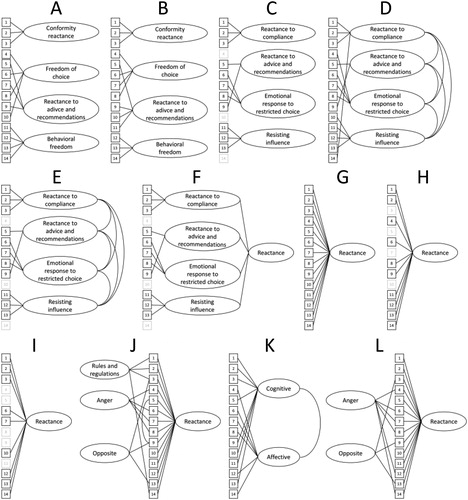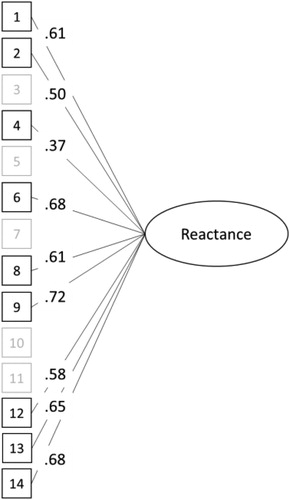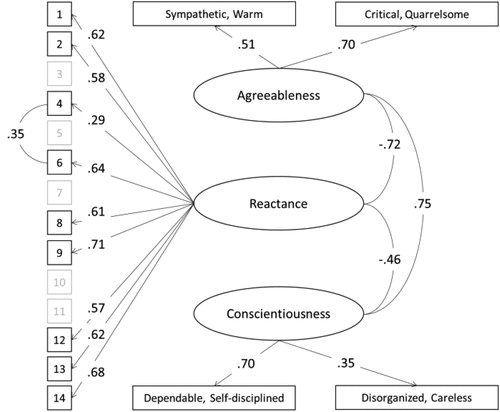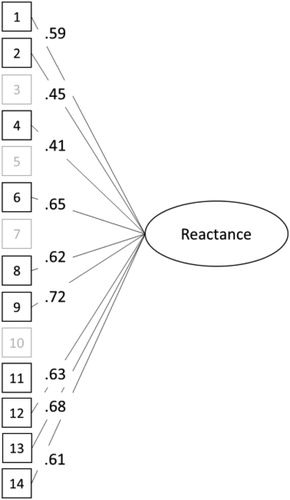Figures & data
Figure 1 Previously reported factor-structures for the Hong Psychological Reactance Scale. Numbers 1–14 represent the scale items.
A = Hong and Page (Citation1989). Principal component analysis on 14-item scale, n = 257.
B = Hong (Citation1992). Principal component analysis on 14-item scale, n = 462.
C = Hong and Faedda (Citation1996). Principal component analysis on 11-item scale, n = 3085.
D = Thomas et al. (2001 A). Confirmatory factor analysis (CFA) on 14-item scale, n = 905.
E = Thomas et al. (2001 B). CFA on 11-item scale, n = 539.
F = Shen and Dillard (Citation2005). CFA on 11-item scale, n = 621.
G = Jonason and Knowles (Citation2006 A). CFA on Tucker and Byers (Citation1987) 18-item scale (only 14 items included here), n = 288.
H = Jonason and Knowles (Citation2006 B). CFA on Tucker & Byers’ (1987) 18-item scale (reduced scale, only 14 items included here), n = 288.
I = Jonason et al. (Citation2010). Principal component analysis and CFA on 18-item scale (Tucker & Byers, Citation1987) (reduced scale, only 14 items included here), n = 240.
J = Brown et al. (Citation2011). CFA on 14-item scale, n = 1286.
K = De las Cuevas et al. (Citation2014). Principal component analysis and CFA on 14-item scale, n = 354.
L = Moreira et al. (Citation2019). CFA on 14-item scale, n = 1301 & 327 (adolescents).

Table 1 Descriptive statistics of the subsamples in Study 1.
Figure 2 Factor loadings in the best-fitting confirmatory model H of the Hong Psychological Reactance Scale.

Table 2 Fit statistics of previous Hong Psychological Reactance Scale models.
Table 3 Factor loadings and communalities in the one-factor Hong Psychological Reactance Scale.
Table 4 The polychoric (below diagonal) and Pearson (above diagonal) correlation matrices of the Hong Psychological Reactance Scale.
Figure 3 Model depicting the associations between latent variables for trait reactance (Hong Psychological Reactance Scale, reduced ancillary model), Agreeableness, and Conscientiousness (Ten Item Personality Inventory). N = 624. Missing data – Sympathetic, Warm: 0.80%; Dependable, Self-disciplined: 0.32%; Disorganized, Careless: 0.64%; Number of missing patterns: 6.

Table 5 Descriptive information of the sample recruited via Facebook.
Figure 4 Factor loadings in the best-fitting confirmatory model H of the Hong Psychological Reactance Scale.

Table 6 Fit statistics of eleven previous Hong Psychological Reactance Scale models.
Table 7 Exploratory factor analysis loadings and communalities of the one-factor Hong Psychological Reactance Scale.
Table 8 The polychoric (below diagonal) and Pearson (above diagonal) correlation matrices of the Hong Psychological Reactance Scale.
